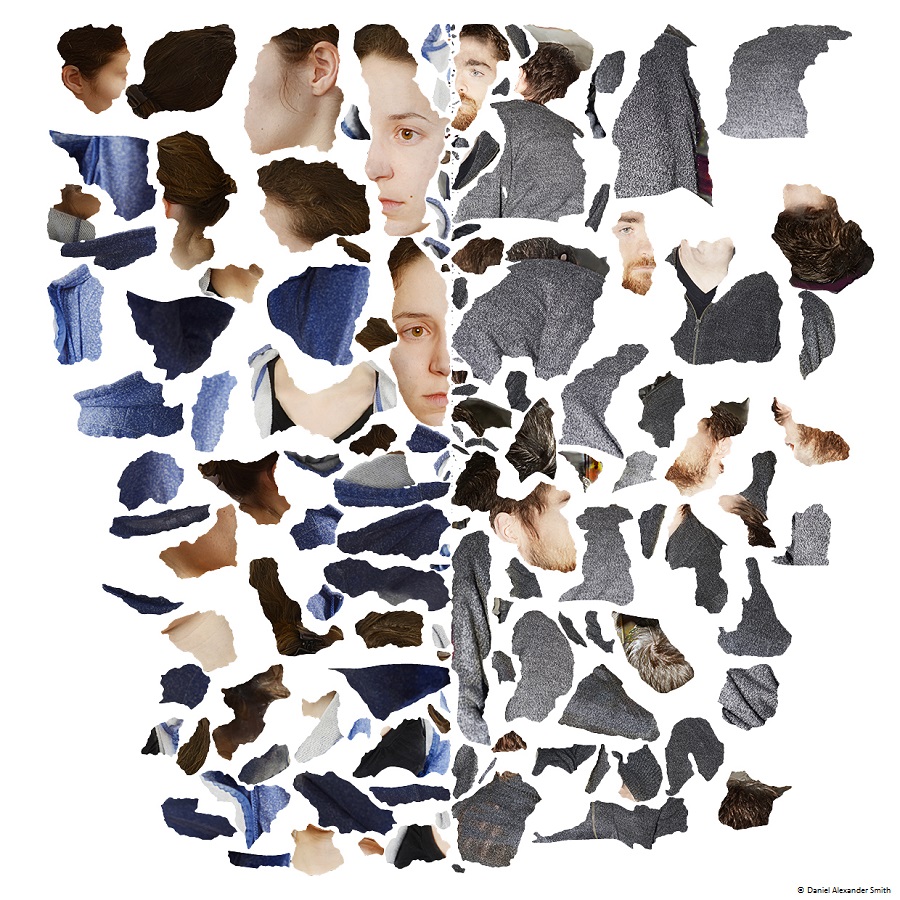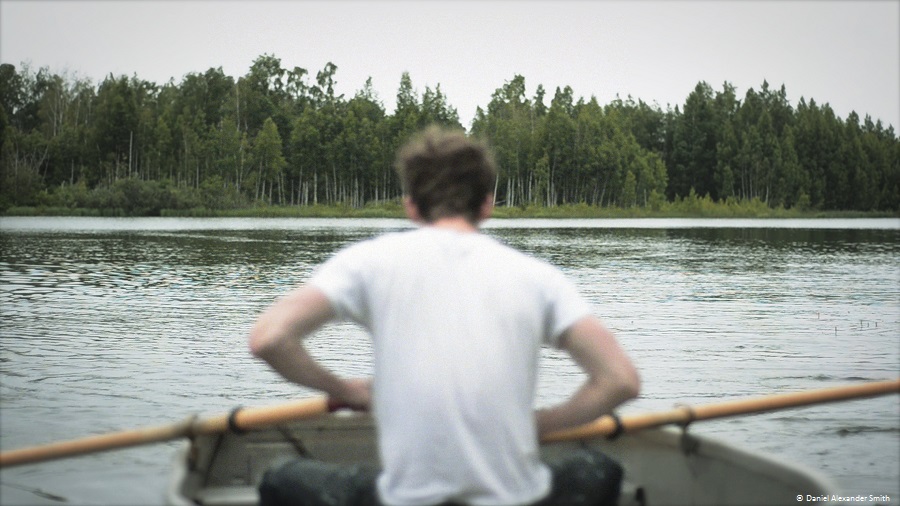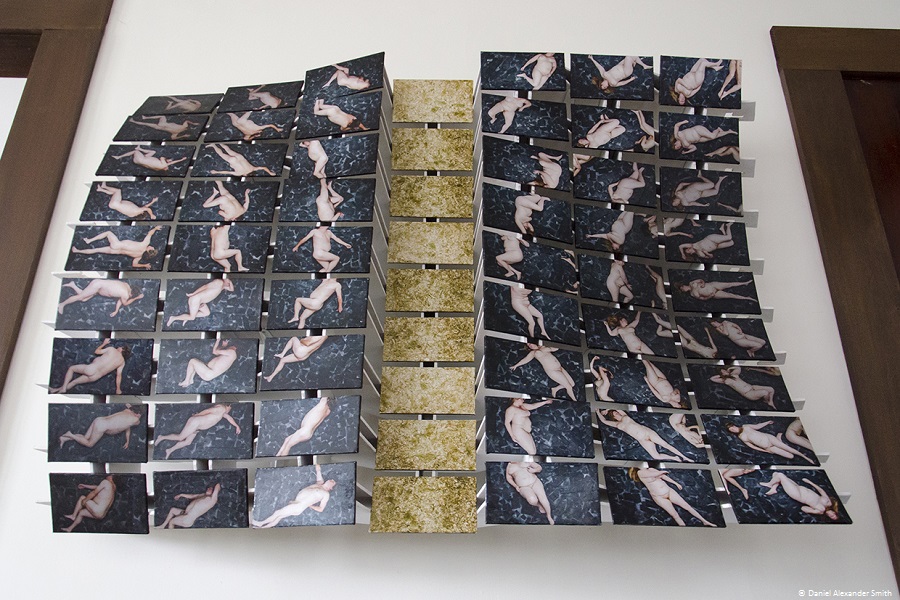January 7, 2016
Hyeyong Yun (H): Hello Daniel, Nice to meet you! I am very glad to have a chance to talk about your works today.
Firstly, I have a question regarding your video work, Sea Change. For me, Sea Change seems like an endless research on unknown space. In the work, sea waves are transformed into abstract geographical landscapes. I also see your on-going interests in “space” in your works, such as Music of sphere and Pedestal. Could you please tell us more about your artistic concepts of space.
Daniel Alexander Smith (D): Throughout history, images present conceptions of space. The iconism of medieval imagery conveys an abstract, theological view of the world. The linear perspective of the Renaissance suggests a view in which religious abstraction became accessible, because the painting became a window rather than a wall. The flatness of modernism reflects collapsing hierarchies and the confusion of post-industrial life. Today, the computer image has reinvented contemporary ideas about space. Computer imagery fluctuates between the abstract and hyperreal. I’m interested in how technology has shaped our ideas about space in the past and present. Right now, my work uses the space of images to discuss the alienation of individuals in the technological present.

Daniel & Anna, Unfolded Together

Still Image from Sea Change
H: You mentioned that you were inspired by The Tempest (1610-11) by William Shakespeare, when making Sea Change. You also mentioned Dante in your another work Inferno. It seems that literature is one of your key interest in your art project. Please tell us about how you get inspiration from literature.
D: My first experiences with art were literary. My brother is a writer, and I grew up reading contemporary and classical literature. The concept of tragedy, the structure of narratives, and the philosophies of the ancients have evolved over thousands of years, filtered through countless writers and artists. I think great artwork marries these themes of the past with the ideas of the present.
H: In Sea Change, there are juxtaposition of virtual landscape and real landscape. Are there any certain reason of mixing the virtual/non-virtual imagery?
D: Yes. The term “sea change” originates in Shakespeare’s The Tempest, and it refers to any dramatic and fundamental change. In my video, this change occurs both in the natural world and our relationship to nature. I believe technology isolates the individual and ultimately replaces her humanity. Simple examples of something like this are the farmer replaced by automated plows, the truck driver replaced by the driverless car, the computer programmer replaced by an algorithm. A more complex example of this is the conversation replaced by typed questions sent over the internet. My video, Sea Change, tries to represent the way technology overtakes the natural world and eventually isolates the human individual.
H: Now I have question about Paper-Thin project. It looks like a so-called “Artist collective” work, which I have seen in Europe many times. Could you talk more about Paper-Thin project – the purpose and how collaborations with artists are going so far?
D: Paper-Thin is the result of fascination and frustration with art world conventions for presenting artwork. The thought was to make a space that is universally accessible for free and which allows artists to physically transform the space into anything conceivable. The physical and financial limitations of existing museums and galleries create enormous constraints, which Paper-Thin circumvents through the use of virtual rather than physical space.
So far, curating and collaborating with artists has been very rewarding. There is a show every month, so we have to work very fast. I have a collaborator, Cameron Buckley, who works with me on the production of Paper-Thin, which makes the quick pace possible. As an artist, I’m invested with the development of these individually, but as a curator, I’m excited to see how the shows relate to each other throughout the virtual architecture.
H: What made you create virtual reality art? And how do you define this genre of artwork?

Gold Standard
D: I was working on a sculptural frieze, Gold Standard, that was far too complex to construct by hand, so I learned how to use 3D modeling software. During this process the physical aspect of creation seemed less and less relevant to me. I’m trained as a photographer, so the more I’ve used computer rendering, I get the feeling that virtual reality is the future of images. Paper-Thin is an attempt to shape this future.
H: Finally, the last question. Let me know more about your future plan for art!
D: Well, I’m currently working on the final artist installations for Paper-Thin. After these, Cameron and I will open a new, and quite different space for the next 12 installations at Paper-Thin. We’re collaborating with a professional architect, and working towards a more interactive space.
As for my other work, this spring I’m finishing my master’s thesis, Poly_Count. After that, I’ll be moving to Boston and figuring things out from there.
H: So that’s it for my questions. Thank you for your time, Daniel!
Thank you sincerely. I will expect a very nice show in CICA museum and I hope that I can see you in person!
D: Thank you! It’s a pleasure to participate in CICA’s upcoming show, and discuss the work with you.

Daniel Alexander Smith
Daniel Alexander Smith is a visual artist working in photography, sculpture, and virtual imaging. He is currently an MFA Fellow at Indiana University.
With his collaborator, Cameron Buckley, Daniel directs Paper-Thin, an online virtual reality art archive. His work has been exhibited nationally and internationally at venues including the Indianapolis Museum of Art; Besharat Gallery & Fay Gold Gallery in Atlanta; Manifest Gallery in Cincinnati, OH; and the Center for Fine Art Photography in Ft. Collins, CO. In 2014, he curated Beyond Mapplethorpe, part of a collection of exhibits supported by The Robert Mapplethorpe Foundation and the Kinsey Institute. In 2012, he was selected as one of ten up and coming photographers for Atlanta Celebrates Photography’s Ones2Watch. His research has received grant funding from the University of Georgia, Ideas for Creative Exploration, and Indiana University’s School of Fine Arts.
Recent works include Poly_Count, a collection of images and objects investigating the fluidity of the material and virtual. Ruckenfigur, a series playing with the physical relationship to images; and Gold Standard, an installation addressing iconism in the de-mythologized present.
 Hyeyong Yun
Hyeyong Yun
Hyeyong Yun is an artist and writer based on Seoul, Korea and France. She studied and lived in Western Europe for ten years while achieving her artistic career. Quite much influenced by European sound art, experimental films, and French utopian architecture. She is open to talk about art with anyone.
윤혜영 (H): 안녕하세요 다니엘씨, 만나서 반갑습니다! 오늘의 작품에 대해 이야기 할 수 있는 기회를 가지게 되어 매우 기쁩니다.
우선 아트 옐로 북 전시에서 선보인 Sea Change라는 비디오 작품에 대해서 질문이 있습니다. 이 작업은 미지의 우주세계를 끊임없이 탐험하는 것처럼 보이는데 이 비디오 안에서 파도가 점차 추상적인 지질학적 경치로 변화되는 것처럼 느껴졌습니다. 또한 다니엘 씨의 다른 작업인 Music of sphere나 Pedestal 의 작업에서도 우주에 관한 작가의 관심을 느꼈습니다. 이에 관해서 당신의 예술가적 생각을 설명해주실 수 있나요?
Daniel Alexander Smith(D): 제 생각에 이미지는 역사를 통해 공간의 개념을 재현해 왔습니다. 서양의 중세시대에는 이미지의 우상화를 통해 세상을 추상적이고 종교적으로 바라보았습니다. 르네상스시대의 직선 원근법은 그림이 벽이라기 보다는 하나의 창문으로 간주되었기 때문에 종교의 추상적 접근이 가능하게 되었지요. 더 나아가 모너니즘에서 나타나는 이미지의 평면성은 계급주의가 무너진 후기 산업화로 인한 삶의 혼돈을 반영한다고 생각합니다. 오늘날 컴퓨터 이미지는 동시대적인 새로운 생각과 공간을 다시 만들어냈다고 생각합니다. 컴퓨터가 만들어내는 이미지는 추상과 과도한 현실 세계를 변동시킵니다. 저는 과거와 현재에서 나타나는 공간 개념이 현실화되는 과정에 관심이 있습니다. 최근에는 오늘날의 기술이 개인을 소외시키는 것을 표현하기 위해 이미지 공간감을 이용한 작업을 하고 있습니다.

Daniel & Anna, Unfolded Together

Still Image from Sea Change
H: Sea Change 라는 작업이 윌리엄 섹스피어의 Tempest 희극에 영향을 받았고 다른 작업에서도 단테의 Inferno 에 영향을 받았다고 말씀 하셨는데요, 문학이 다니엘 씨의 작업에 중요한 관심사로 보이는데 어떻게 영감을 받으시는지 알려주시기 바랍니다.
D: 제가 예술을 접하게 된 첫 계기는 바로 문학을 통해서였습니다. 제 형제는 글 작가이고 저 또한 동시대적 문학과 고전을 읽으면서 자랐습니다. 비극이란 개념 독백의 구조 그리고 옛 고전 철학은 셀 수도 없는 작가와 예술가를 통해서 수 천 년의 역사를 가지면서 진화되었다고 봅니다. 전 그래서 위대한 예술작품은 과거의 이런 주제가 작가의 현재 생각과 같이 결합이 되어서 탄생된다고 믿습니다.
H: 다니엘씨의 Sea Change에서 가상의 풍경과 진짜 현실의 풍경이 병렬적으로 나오는 장면이 있습니다. 이 가상과 현실의 이미지를 서로 섞는 특별한 이유가 있습니까?
D: 네. Sea Change란 단어는 세익스피어의 The Tempest 폭풍우에서 유래하였고, 이 것은 극적이고 근본적인 변화를 의미합니다. 제 비디오에서 이 변화는 자연 세계와 자연과 가지는 우리 인간과의 관계 이 둘에서 모두 발생됩니다. 전 기술이 개인을 분리하고 궁극적으로 인류를 대체한다고 생각합니다. 이 같은 간단한 예는 농부가 자동 쟁기로, 트럭 드라이버가 무인 자동차로, 컴퓨터 프로그래머는 알고리즘으로 대체가 된 것을 들 수 있습니다. 이러한 것보다 복잡한 예는 인터넷을 통해 전송되는 질문에 의해 만들어지는 대화입니다. 결국 제 비디오는 기술이 자연을 지배하고 결국 인간을 소외시킨다는 것을 표현하려고 한 작품입니다.
H: Paper-Thin 대해 질문이 있습니다. 이 프로젝트는 제가 유럽에서 자주 경험 한 소위 “아티스트 컬렉티브”로 보이는데 Paper-Thin에 대한 자세한 내용과 목적과 어떻게 작가들과 협력하게 되었는지 설명해주실 수 있나요?
D: Paper-Thin 프로젝트는 예술작업을 보여주는 것에 대한 관습적인 규칙에 대한 매혹과 좌절의 결과입니다. 이 프로젝트의 기본적인 아이디어는 예술가들이 자유롭게 전시할 수 있는 공간을 만들고 이 공간에서 예술가들이 물리적으로 공간을 변형시키는 것입니다. 기존의 박물관과 미술관의 물리적, 재정적 한계는 작가들에게 매우 큰 제약을 주기에 Paper-Thin 이 물리적 공간보다 가상의 공간을 통해 이 제약을 우회할 수 있습니다.
지금까지, 예술가들과 큐레이팅과 협력하는 것은 매우 보람되었습니다. 전시는 매월 열리기 때문에 저희는 매우 빠르게 작업합니다. 저는 카메론 버클리와 함께 협력해서 일하고 있는데, 우리는 최대한 빠른 속도로 일하기 위해 힘쓰고 있죠. 저는 작가로서 이 프로젝트를 개발하고 있기도 하지만 큐레이터로서도 각각의 전시가 가상 건축공간을 통해 연관지어지는 것에 대해 큰 기대를 하고 있습니다.
D: 다니엘 씨는 어떻게 가상 현실 예술을 하게 되었는지 말씀해 주실 수 있나요? 그리고 이 장르를 어떻게 정의하시나요?

Gold Standard
H: 한 때 저는 손으로 만들기에는 너무 복잡한 조각 프리즈 (Gold Standard )를 작업하고 있었기에 3D 모델링 소프트웨어를 사용하는 방법을 배웠습니다. 이 과정에서 창조의 물리적 측면은 제게 시간이 지남에 따라 관련성이 점점 적어지게 되었습니다. 사진 전문적인 트레이닝을 받은 저는 컴퓨터 렌더링에 하면 할 수록 가상 현실이 결국 ‘이미지’의 미래라는 생각을 하게 되었습니다. Paper-Thin 이란 프로젝트는 이러한 미래를 구체화하기 위한 작업입니다.
H: 마지막으로, 당신의 앞으로의 작업 계획에 대해 말해주세요.
D: 저는 현재 Paper-Thin의 최종 설치작업을 하고 있습니다. 이 후에 카메론과 약 12 개 설치 전시 건으로 새로운 컨셉의 공간을 오픈 할 계획입니다.저희는 현재 전문 건축가와 협력해 더 많은 상호 교환적 공간 창조를 위해 노력하고 있습니다.
저의 다른 일에 관해서는, 이번 봄에 Poly_Count에 대한 석사 논문을 마무리할 계획입니다. 그 후, 보스턴에 가서 작업을 계속할 생각이고요.
H: 시간 내 주셔서 감사합니다. CICA 박물관에서 좋은 전시를 기대합니다.

Daniel Alexander Smith
Daniel Alexander Smith는 사진과 조각 그리고 가상 이미지를 작업하는 비주얼 아티스트이다. 현재 전 인디애나 대학에서 석사 연구원으로 있다.
Daniel은 작가 동료 카메론 버클리로와 같이 Paper-Thin 이란 온라인 가상 현실 아트 아카이브를 운영하고 있다. 그의 작품은 인디애나폴리스 예술 박물관을 포함하여 애틀랜타 Besharat 갤러리 & 페이 골드 갤러리, 오하이오 신시내티 매니페스트 갤러리 및 콜로라도 콜린스의 현대예술 센터 등 국내외에서 소개 되었다. 2014 년, 로버트 메이플 소프 재단과 킨제이 연구소가 지원하는 컬렉션 전시 ”Beyond Mapplethorpe ” 의 일부를 큐레이팅했고, 2012 년, Atlanta Celebrates Photography’s Ones2Watch 행사에 10 위 안에 뽑힌 사진 작가로 선정이 되기도 했다. 그의 연구는 조지아 대학과, 창조적 탐사를 위한 아이디어 단체, 그리고 인디애나 대학에서 후원을 받았다.
최근에는 실제와 가상 사이의 유동성을 연구한 이미지와 사물의 컬렉션인 Poly_Count 스타일식 3D 와 비디오 게임도 포함한 작업을 하고있다. 작품 Ruckenfigur는 이미지에 대한 물리적 관계를 플레이한 시리즈이고 Gold Standard 는 탈 신화화된 현시점에 만연한 우상주의에 대한 작업이다.

윤혜영
윤혜영은 프랑스와 한국을 오가면서 작업하는 예술가이자 작가이다. 서유럽에서 10년 정도 거주하면서 공부하고 전시활동을 했고 유럽의 사운드 아트와 실험 영화 그리고 프랑스 유토피아적 건축에 영향을 받았다.
